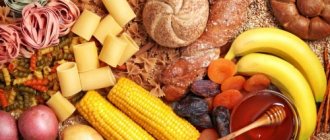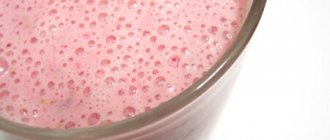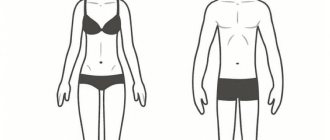In this article we will tell you:
- Classification of carbohydrates
- Daily intake of fructose and sugar
- Interesting facts about carbohydrates
- Foods rich in complex carbohydrates
- Daily carbohydrate intake and glycemic index
- 6 Rules for Eating Carbohydrates
- Symptoms and causes of carbohydrate metabolism disorders
- Low carb diets
- Fast carbohydrates for gaining muscle mass
- General carbohydrate intake recommendations
Complex carbohydrates are needed by the body to provide energy. Their deficiency causes a feeling of hunger. Many foods are rich in complex carbohydrates.
The main function of carbohydrates is to provide the body with energy. Although carbohydrates as sources of energy can be replaced by proteins and fats, the absence of carbohydrates in food can adversely affect health.
Classification of carbohydrates
Carbohydrates
- organic compounds that are part of all living organisms.
The lack of carbohydrates in food is manifested by symptoms reminiscent of starvation. There is rapid loss of water and sodium.
They are divided into monosaccharides, oligosaccharides and polysaccharides.
| Functions | Characteristic |
| Energy | The main substrate for energy production. |
| Structural | They are membrane components and participate in the production of lipids and non-essential amino acids. |
| Storage | Glycogen in the liver and muscles is a reserve of nutrients. |
| Regulatory | Digestive regulators. |
| Receptor | Cell receptors are glycoproteins. |
| Protective | Antibodies – glycoproteins, mucus, heparin. |
| Information | Ribose is a key component of RNA and DNA. |
- Simple carbohydrates
Water-soluble white crystals, sweet in taste, quickly absorbed, substrate for fermentation reactions. They have a higher glycemic index and cause insulin spikes in the blood.
Simple carbohydrates are called monosaccharides and oligosaccharides.
- Monosaccharides
Galactose, milk sugar, is a component of lactose and is found in milk.
Glucose, grape sugar - found in grapes, fruits, honey. It is the end product of the breakdown of complex carbohydrates in the body and is easily fermented.
Fructose, fruit sugar, is 2.5 times sweeter than glucose and does not cause a rise in insulin. Contained in honey and fruits. Worse to ferment.
- Oligosaccharides
Sucrose (glucose + fructose), cane beet sugar - table sugar. Contained in honey, dates, grapes, figs, persimmons, prunes, raisins. Displaces copper, chromium and B vitamins from the body, increasing the risk of developing CVD.
Lactose (glucose + galactose), milk sugar - easily transforms into adipose tissue (used for weight gain), stimulates the growth of lactic acid bacteria in the intestines.
Maltose (glucose + glucose), malt sugar, is an intermediate product of starch hydrolysis. Contained in wheat, rye, malt extracts, sprouted grains.
- Complex carbohydrates
Peculiarities:
- Low glycemic index.
- Does not cause insulin spikes.
- They have a mechanical effect on the intestines.
- Slow down the process of movement of the food bolus through the gastrointestinal tract.
Complex carbohydrates include polysaccharides. Polysaccharides are divided into homopolysaccharides and heteropolysaccharides.
- Homopolysaccharides
Starch is the stored energy of plants. Digestion of starch begins in the mouth. Contained in potatoes, cereals, pumpkin, peas.
Glycogen is animal starch, stored energy. Synthesized during digestion (1-2 hours after ingestion of carbohydrate foods), the largest amount of glycogen is stored in the form of granules in liver cells (2/5 - 150g), in skeletal muscles (1-3%), in the heart (0.5% ).
Cellulose (fiber) is the main component of the cell wall of higher plants, algae. Promotes the movement of food through the intestines, is broken down in the large intestine with the participation of microbiota, and inhibits the absorption of microelements.
Hemicellulose is better soluble in water and has sorption properties.
Lignin is the matrix of plants, determines their strength, the richest is coniferous wood, and from food sources: bran, stale vegetables. It is not digested in the intestines, reduces food digestion and absorption and has a high sorption capacity.
- Heteropolysaccharides
Pectin is present in the intercellular space of all higher plants, most of all in fruits. It has mild sorption and chelator properties.
We recommend
“Microelements in the body: consumption standards and methods of replenishing the deficiency” Read more
Inulin is similar to starch. Contained in underground parts of plants (mostly in Jerusalem artichoke, chicory), binds glucose, prebiotic.
List of foods containing complex carbohydrates
Foods containing complex carbohydrates do not taste sweet. Sweetness is characteristic of fast compounds. Also, polysaccharides are famous for their low glycemic index, which is very important for diabetes. For diabetics, such products are simply a salvation. They do not provoke a sharp increase in both insulin and blood glucose.
In addition, complex carbohydrates (foods) are practically insoluble in water. This means that their use does not cause deposits in the form of subcutaneous fat. The only thing to consider is the number of calories. Such products mainly differ in their calorie content. What are complex carbohydrates? In general, the list of foods rich in slow compounds is as follows:
| Fruits | Pomegranate, apples, citrus fruits, peach, plum, quince. |
| Vegetables | Potatoes, tomatoes, cucumber, zucchini, cabbage, bell peppers, carrots, pumpkin, celery. |
| Berries | Gooseberries, blackberries, cherries, currants (black), olives. |
| Milk products | Natural yogurt, low-fat kefir, low-fat cottage cheese. |
| Cereals | Buckwheat, oatmeal, pearl barley, wheat porridge, brown rice. |
| Legumes | Beans, lentils, green peas, nuts, chickpeas. |
| Cereals | Durum wheat pasta, rye bread, crispbread. |
| Dried fruits | Dried apricots, dried apple, prunes, figs. |
| Seeds | Pumpkin and sunflower seeds. |
Some juices also contain polysaccharides. These include tomato, apple, carrot and pineapple. Various greens and leafy vegetables can be added to the list of products with complex compounds. But seafood, meat, milk and baked goods are considered sources of simple carbohydrates.
Fructose consumption rate
Consumption rate: maximum 25 g per day.
In people with metabolic syndrome and risk factors: no more than 15 g.
50 g per day can cause metabolic syndrome and other diseases (metabolic gout).
Sources of fructose:
- Fruits.
- Vegetables.
- Honey.
- Products with fructose.
- High fructose corn starch.
- Sucrose – table sugar (glucose + fructose).
Sources of fructose in fruits and berries:
| Fruit | Size | Fructose (g) |
| Lime | 1 medium | 0 |
| Lemon | 1 medium | 0,6 |
| Cranberry | cup | 0,7 |
| Passion fruit | 1 medium | 0,9 |
| Plums | 1 medium | 1,2 |
| Apricot | 1 medium | 1,3 |
| Date (Deglet Noor) | 1 medium | 2,6 |
| Raspberries | 1 cup | 3,0 |
| Clementines | 1 medium | 3,4 |
| Kiwi | 1 medium | 3,4 |
| Blueberry | 1 cup | 3,5 |
| Cherries | 10 | 3,6 |
| Strawberry | 1 cup | 3,8 |
| Cherry | 1 cup | 4,0 |
| A pineapple | 1 piece | 4,0 |
| Grapefruit | 1.2 average | 4,3 |
| FRUIT | SIZE | GR. FRUCTOSE |
| Mandarin | 1 cup | 4,8 |
| Nectarine | 1 medium | 5,4 |
| Peach | 1 medium | 5,9 |
| Orange | 1 medium | 6,1 |
| Papaya | 1/2 medium | 6,3 |
| Honey Melon | 1/8 average | 6,7 |
| Banana | 1 medium | 7,1 |
| Date (Medjool) | 1 medium | 7,7 |
| Apple | 1 average | 9,5 |
| Melon farmer | 1/16 average | 11,3 |
| Pear | 1 medium | 11,8 |
| Grape | ¼ cup | 12,3 |
| Seedless grapes | 1 cup | 12,4 |
| Mango | ½ average | 16,2 |
| Dried apricots | 1 cup | 16,4 |
| Dried figs | 1 cup | 23 |
Are fruits really evil? No, fruit is not evil. Different fruits contain different amounts of fructose. Fruits reduce the risk of developing CVD due to their content of other nutrients and polyphenols. They are recommended in many diets, including the DASH (Diet to Stop Hypertension) protocol.
Studies have shown that fruit components such as vitamin C, resveratrol, polyphenols, and antioxidants improve the condition and function of blood vessels. Better fructose + vitamin C in fruits.
The fructose content of fruits is relatively low. The fructose content increases in fruit juices, as do calories. Some fruit juices contain up to 26 g of fructose per 450 g. Some restaurant desserts contain up to 60 g of fructose per serving.
The effect of carbohydrates on the body
Yes, complex carbohydrates are not suitable for closing the carbohydrate window. The thing is that due to the low rate of breakdown, they do not have time to cover the caloric deficit and the body begins optimization processes, which is fraught with additional muscle destruction. However, this can also be used to your advantage (source – NCBI).
- First, slow carbohydrates help you stay full longer. This is important in cases where a person goes on a low-carbohydrate diet, which is characterized by limiting not only calories, but also reducing the amount of nutrients.
- Secondly, slow carbohydrates maintain a positive energy balance throughout the night.
Therefore, it is important to load up on slow carbohydrates along with casein protein at night. This will avoid optimization processes.
And most importantly, slow carbohydrates are not stressful for the body, since they do not create dopamine and energy surges, which are characterized by further exhaustion without maintaining an appropriate energy level with external nutrition.
Sugar intake per day
Free sugar = added by human hands.
Based on an average daily caloric intake of 2000 kcal, 10% free sugar from the total daily caloric intake of food.
Calculation example
:
- 10% of 2000 kcal = 200 kcal.
- 1 tsp without top sugar = 4 g.
- 1 g sugar = 4 kcal.
- 1 tsp = 16 kcal.
- 200 kcal = 12 tsp. Sahara.
- Daily sugar consumption 12 tsp.
BUT! This is a lot - maximum 50% - 6 tsp.
Another example of calculation for a box of chocolates. Total weight of the product in the box is 370 g. Quantity: 10 candies. 1 candy = 37 grams.
According to the labeling, 100 g of sweets contains 48 g of sugar. 1 candy 37 g = 17.7 g sugar.
17 g sugar = 4 tsp.
2 candies = reserve of “free sugar” allowed by the good WHO per day.
What are complex carbohydrates and why you shouldn’t be afraid of them
Complex carbohydrates are organic compounds needed by the body for energy. At a chemical level, they are all composed of carbon, oxygen and hydrogen. Their use allows you to ensure normal functioning and build immunity. Organizing proper nutrition involves fairly precise regulation of carbohydrate intake. To create the right diet, you need to know about the content of these substances in different foods. Below is a table of foods that contain complex carbohydrates:
| Sources of carbohydrates (100 g) | Carbohydrates (g) |
| All bran | 80 |
| Muesli | 77 |
| Corn | 77 |
| Corn flour | 73 |
| Buckwheat | 71 |
| Oat bran (raw) | 66 |
| Oatmeal | 62 |
| Wheat germ (raw) | 51 |
| Rye bread | 48 |
| Whole wheat bread | 41 |
| Corn spaghetti | 30 |
| Barley (raw) | 28 |
| Yam (raw) | 28 |
| Brown long grain rice | 23 |
| Lentils (boiled) | 20 |
| Potatoes (boiled, in their jackets) | 20 |
| Peas | 8 |
There are foods containing complex carbohydrates and foods containing simple carbohydrates. The latter are quickly absorbed and transfer energy to the body. In the process, the concentration of glucose in the blood increases. If there is an excess of “fast” energy, it will be converted into fat cells. Therefore, it is better to consume such products at the beginning of the day. Products with complex carbohydrates take a long time to digest, while the body consumes a relatively large amount of oxygen and energy. Consumption of such food provides an important source of energy that will fuel a person for a long time.
Interesting facts about carbohydrates
- Fats and carbohydrates are highly interrelated. When we don't have enough fat, we may crave carbohydrates.
- Carbohydrates are cellular “firewood”; their first and only function is to provide us with energy. No other molecule can provide as much energy without toxins.
- But besides this there are several more functions. Oddly enough, carbohydrates cannot be called an essential source of food. If there is a lack of carbohydrates, we can live without them, but there will be more toxins, less energy and a depressed state, but our body can create the carbohydrates that we need on its own!
- A carbohydrate is a mixture of carbon and water! Formed in plants under the influence of solar energy. Carbohydrates are an energy pantry: the body is able to store carbohydrates in reserve in the form of glycogen, which is stored in the liver and muscles.
- When the body does not have enough carbohydrates, it is ineffective, drowsy and in a bad mood.
- A special feature of carbohydrates is their ability to sharply increase blood glucose levels. The body’s reaction is immediate: a powerful release of insulin occurs in the pancreas - a hormone designed in this case to neutralize excess glucose in the blood, otherwise it will “thicken”. The main task of insulin is to deliver glucose to the cells that need it, in particular muscle cells.
- Body tissues have a limit for glucose absorption. By getting rid of its excess, insulin promotes its conversion into triglycerides, the main material of adipose tissue. Simple carbohydrates that are not used as sources of energy usually settle in the body in the form of hated subcutaneous fat. This is the reason obesity is so common among people who do not exercise. Their muscles practically do not need energy supply, and almost all the glucose received from food is converted into fat.
- With a sharp increase in blood glucose levels, the synthesis and storage of fat from carbohydrates, as well as the storage of fat from food, is activated. This happens even with a small amount of carbohydrates in food, but with their rapid absorption and with a sudden increase in blood glucose levels. This situation triggers the accumulation of fat in adipose tissue. A factor in the rate of carbohydrate absorption is the glycemic index (GI).
Types of complex carbohydrates
A complex carbohydrate is made up of three or more simple carbohydrate molecules. They are also called polysaccharides. You can often find names: “slow”, “useful”, “long”, etc. The difference from simple ones is that these substances do not cause a sharp rise in insulin. Since their breakdown occurs much more slowly than simple carbohydrates. The body has to expend energy to absorb them. Therefore, saturation persists for several hours.
Starch
This substance is not very high in calories, but it has great energy value. Starch is included in many diets. And all because it gives a feeling of satiety that lasts for a long time. In the famous Dukan diet you can see recipes using starch.
In addition, the product has a lot of useful properties:
- normalizes metabolism;
- regulates blood glucose levels;
- strengthens the immune system;
- reduces the risk of cancer.
The most starch is found in brown rice, potatoes, soybeans, peas, lentils, oatmeal, and buckwheat.
Glycogen
This is a complex substance that consists of a chain of glucose molecules. Helps maintain proper blood sugar levels. A very useful and necessary substance for athletes, as it restores muscle mass. This substance “turns on” the function of protein synthesis. 3 hours after eating, glycogen is actively consumed. If you work out in the gym, its reserves will run out within 30 minutes.
It is very important for normal muscle function to replenish the supply of this substance. In the foods we are used to, glycogen is not contained in sufficient quantities in its pure form. Our body synthesizes it most quickly from the liver of animals. Plus it is also found in fish.
Pectins
About two centuries ago, this polysaccharide was discovered in fruit juice by the scientist Braconno. It was then that the beneficial properties of pectins were identified and described. They are able to absorb harmful substances that come to us with food. It is believed that regular consumption of pectins allows you to maintain youth longer.
ARTICLES ON THE TOPIC:
- How many carbohydrates do you need per day when losing weight and which carbohydrates are important?
- What are fast carbohydrates and where they are found - a list of products is attached + table with GI
- Which vegetables can you eat when losing weight, even without restrictions, and which ones you shouldn’t...
Pectins are a thick sticky substance. Very often it is used as a thickener, gelling agent, and stabilizer. The main source of pectins is fruits. Apples and oranges contain the most pectin. It is also found in apricots, plums, pears, quinces, cherries, and dates.
On an industrial scale, the substance is obtained from plant cake. The additive is designated as E440. You shouldn’t be afraid of it - it’s a completely natural and healthy product.
Cellulose
A polysaccharide that is found in most plant foods. Our digestive enzymes cannot digest it. But the intestinal microflora processes fiber perfectly. At the same time, the gastrointestinal tract is stimulated and helps remove harmful cholesterol. Plus, fiber gives you satiety and a feeling of a full stomach.
Rye and wheat bran, mushrooms, carrots, beets, broccoli, cabbage, etc. are rich in fiber.
Foods rich in complex carbohydrates
| Product | Carbohydrate content per 100 grams, g |
| Cereals | |
| Cereals | 61 |
| Amaranth | 31 |
| Pearl barley | 65 |
| Bulgur | 76 |
| Millet | 67 |
| Brown rice | 74 |
| Wild rice | 75 |
| Whole grain spelled | 70 |
| Buckwheat | 57 |
| Quinoa | 64 |
| Barley grits | 66 |
| Whole wheat flour | 72 |
| Legumes | |
| Green pea | 15 |
| Beans raw | 12 |
| Dried beans | 49 |
| Chickpeas | 64 |
| Beans | 47 |
| Lentils | 60 |
| Peanut | 14 |
| Vegetables | |
| Carrot | 8 |
| Tomato | 4 |
| Celery | 2 |
| Beet | 6 |
| Turnip | 6 |
| Eggplant | 7 |
| Asparagus | 3 |
| Cucumber | 4 |
| Broccoli | 7 |
| Onion | 7 |
| Radish | 3 |
| Rhubarb | 4 |
| bell pepper | 7 |
| Fresh white cabbage | 5 |
| Red cabbage | 5 |
| Sea kale | 3 |
| Zucchini | 5 |
| Lettuce | 2 |
| Sorrel | 4 |
| Fruits | |
| Pomegranate | 15 |
| Green banana | 22 |
| Apples | 10 |
| Oranges | 8 |
| Figs | 12 |
| Peach | 10 |
| Pear | 11 |
| Grapefruit | 6 |
| Lemon | 3 |
| Avocado | 6 |
| Berries | |
| Cranberry | 4 |
| Prunes | 38 |
| Plum | 10 |
| Raspberries | 6 |
| Blueberry | 8 |
| Gooseberry | 9 |
| Strawberry | 8 |
| Cherries | 10 |
| Currant | 8 |
| Nuts, seeds | |
| Sunflower seeds | 16 |
| Pumpkin seeds | 17 |
| Linen | 12 |
| Sesame | 12 |
| Poppy | 15 |
| Hazelnut | 17 |
| Almonds raw | 20 |
| Cashew | 23 |
| Pine nut | 13 |
| Pistachios | 28 |
| Walnut | 16 |
What are carbohydrates: a little chemistry and biology
From the school course in organic chemistry, we know that carbohydrates are a class of substances that are extremely widespread in nature and are of enormous importance for animals and humans.
Simple carbohydrates include: · monosaccharides - glucose, fructose and galactose; · disaccharides, including sucrose, lactose and maltose, whose molecules consist of two monosaccharides.
In addition, this group of carbohydrates includes other substances with a more complex structure. Once in the human body, carbohydrates, under the influence of special enzymes, undergo a process of hydrolysis, breaking down into monosaccharides. These simplest representatives of the class of carbohydrates are very quickly absorbed by the human body, acting as an energy carrier that provides energy to the cells of our body. Of course, this is not the only purpose of carbohydrates; they are involved in various biological processes. What then is the insidiousness of simple carbohydrates? Have you noticed that after eating sweets, sometimes you want sweets again? This happens because when any of the simple carbohydrates enter the body, there is a rapid increase in blood sugar levels. However, it is also decreasing quickly. This means that the body begins to require a new portion of simple carbohydrates.
Daily carbohydrate intake
| Carbohydrates | Gram per day | Comments |
| Complex carbohydrates | 210 g | Try to avoid simple carbohydrates and maximum complex ones |
| Cellulose | 40 g | |
| Fructose | 25 g | Glycation reactions |
| Sucrose | 25 g, max 50 g | WHO recommends no more than 10% of all carbohydrates, ideally no more than 5% |
| Total | 300 g | For a person with average physical load |
What are carbohydrates?
Carbohydrates are one of three macronutrients that provide the body with energy. The other two are protein and fat.
There are three main classes of carbohydrates:
- Sugars : Single sugar molecules or short chains of sugar molecules. These include glucose, fructose, galactose and sucrose.
- Starches : Longer chains of carbohydrate molecules that need to be broken down in the digestive system.
- Fiber (dietary fiber) : carbohydrates that the body cannot digest (insoluble fiber).
The main function of carbohydrates is to provide the body with energy.
Most carbohydrates entering the digestive system are broken down into glucose and provide the body with energy to perform basic functions. Each gram of carbohydrates provides the body with four calories. The exception is fiber, which usually does not contain many calories ().
Summary:
Carbohydrates are macronutrients that provide the body with energy. Carbohydrates include sugars, starches and fiber.
Glycemic index of carbohydrates
The glycemic index of carbohydrates is influenced by:
- Carbohydrate structure
The most easily digestible carbohydrate is glucose, since after absorption it can be directly delivered by the blood to organs and tissues. Accordingly, other carbohydrates first require conversion to glucose.
Fructose, although a monosaccharide, requires a fairly long sequence of biochemical reactions to be converted into glucose and therefore has a relatively low glycemic index for a monosaccharide.
On the other hand, most disaccharides (sucrose, lactose) contain a relatively easily cleaved glucose fragment in the molecule. For example, the GI of maltose (malt sugar) for glucose is above 100, since the molecule consists of two glucose molecules.
- Particle size
The smaller the particles of carbohydrate food (for example, flour milling), the faster they are digested in the gastrointestinal tract.
- Degree of heat and cooking
Starches are partially broken down when heated. Consequently, the glycemic index increases with increasing duration and intensity of heating. An acidic environment also promotes the breakdown of starches.
- Content of fiber, protein and fat in the product
All these components slow down the absorption of carbohydrates. Fat also slows down secretion, which means the time food stays in the stomach increases. Carbohydrates are mainly absorbed in the intestines, therefore, the faster they get there, the higher the glycemic index.
- Food consistency
Naturally, liquids are the easiest to digest. The presence and density of cell membranes, various partitions and fibrous structures are also important.
- Food absorption rate
On the one hand, hasty swallowing partially speeds up the processing of food, on the other hand, the presence of unchewed pieces interferes with the full absorption of food components.
Using this formula as an example, you can compare the glycemic index of a donut and watermelon
:
Donut GI = 76, carbohydrate content 38.8. GN = (76 * 38.8): 100 = 29.5 g.
Watermelon GI = 75, carbohydrate content 6.8. GN = (75 * 6.8): 100 = 6.6 g.
Glycemic load:
Foods containing complex carbohydrates based on the glycemic index
When following a diet, as well as in the presence of a disease such as diabetes, you need to take into account the level of the glycemic index. He should be short. The table shows products with a low index and the required polysaccharide content:
| Product | Glycemic index | Product | Glycemic index | Product | Glycemic index |
| Green pea | 40 | Figs | 35 | Apple | 30 |
| Grape | 40 | Natural yogurt | 35 | Lentils | 25 |
| Corn grits | 40 | Dried apricots | 35 | Cherry | 22 |
| Orange juice | 40 | Carrot | 35 | Grapefruit | 22 |
| Apple juice | 40 | Pear | 34 | Apricot | 20 |
| Beans | 39 | Peanut | 32 | Eggplant | 10 |
| Rye bread | 39 | Banana | 30 | Broccoli | 10 |
| Wholemeal pasta | 38 | Soy milk | 30 | Tomato | 10 |
| Orange | 35 | Peach | 30 | Sunflower seeds | 8 |
It is very important to combine products correctly. So, carbohydrate foods are not combined with fats. Therefore, it is worth observing separate meals. But proteins and carbohydrates are compatible. Only if polysaccharides are not present in berries or fruits. Including slow carbohydrates in your diet will reduce the number of unhealthy snacks and normalize the functioning of the entire digestive system.
Separately complex polysaccharides are best eaten for breakfast. Thus, a person receives a charge of strength and energy potential. Their breakdown will take a long time, which means the feeling of hunger will not come soon. So, you can maintain your figure without compromising your health.
Symptoms and causes of carbohydrate metabolism disorders
The meaning of carbohydrate metabolism is the release of energy through glucose.
Ways of glucose utilization
:
- entry into cells as a source of energy;
- conversion to glycogen (serves as the main storage carbohydrate and the main form of glucose storage) in the liver and muscles;
- conversion to fatty acids (storage as fat).
Laboratory diagnostics of carbohydrate metabolism
:
- insulin (the norm of insulin is not higher than 5-6, the ideal insulin is 3-4) glucose (the optimum is not higher than 5);
- glycated hemoglobin (shows how “saccharified” our red blood cells have been over the last 3 months, optimal 4-5).
Symptoms of carbohydrate metabolism disorders
:
- dizziness when not eating for more than 3 hours, standing up suddenly or during physical activity;
- you cannot calmly stand a pause of 4-5 hours without food;
- craving sweets and fast carbohydrates, and when you start eating, you can’t get enough;
- behave aggressively when hungry;
- you are overweight and cannot lose it.
Causes of carbohydrate metabolism disorders
:
- Excessive glucose intake.
- Consumption of liquid sugars (any sweet drinks).
- Excessive intake of foods with a high glycemic index.
- Excessive intake of foods with a high insulin index.
We recommend
“Physiology of digestion: stages, organs, enzymes” Read more
Strategy for correcting carbohydrate metabolism
:
- Training food breaks between meals: dinner and breakfast, no snacks!
- Correction of the diet towards LCHF or reducing the carbohydrate load.
- Protein-fat breakfast and low-carb dinner.
- Elimination of simple carbohydrates and glycation products.
- Movement (10,000 steps per day + strength training).
- Do not sit in one place for more than 30 minutes.
General information
Complex carbohydrates are polysaccharides that contain 3 or more molecules of simple carbohydrates. The main representatives of complex carbohydrates are:
- Starch – contributes to the creation of energy reserves. In the digestive tract it turns into glucose.
- Glycogen is the main energy reserve that can be urgently used by the body in case of a lack of glucose. During physical activity, glycogen is broken down to produce energy.
- Maltodextrin is an essential component of gainers and various sports supplements.
- Fiber – helps normalize gastrointestinal tract activity and weight loss (source – Wikipedia).
If you are familiar with the metabolism of carbohydrates, then you know that the body is traditionally accustomed to drawing all its energy from carbohydrates.
It breaks them down completely and releases the resulting sugar into the blood. But the body hides any excess energy in the fat depot. Slow carbohydrates are a way to prevent the accumulation of excess fat. Due to their structure, they are extremely slowly converted into pure sugar, and, therefore, energy enters the blood in doses.
What does this mean in practice:
- The body has time to spend almost all the energy received from slow carbohydrates, therefore, it does not need to convert it into fat.
- If some excess caloric intake is observed, then with slow carbohydrates it will most likely have time to break down into glycogen, bypassing the stage of release of triglycerides and alkaloids.
- Complete absence of load on the liver.
The remarkable properties of complex carbohydrates have made them a traditional source of excess calories in the diet. However, this does not mean that if you replace sweets with porridge, you will begin to lose weight. No, you’ll just be full for much longer, which means you’ll eat less and less often.
Low carb diets
Possible dietary strategies (you must first look at the state of the gastrointestinal tract):
- LCHF
- Keto diet
Basic principles of low-carb diets
:
- Low frequency of meals: ideally 3 meals a day without snacks, observing “clean” intervals.
- Intermittent fasting: 8-10 hours eating, 14-16 hours without food.
- Intermittent 24 hour fasting. Starts from lunch on day X until lunch the next day (for kapha types it may be longer).
- Remove from your diet cereals, baked goods and pasta, legumes, sweets and fruits with a high GI, carbonated drinks (even zero-calorie drinks), juices, candy bars, ketchup (with sugar), etc.
- Increase the consumption of protein products to 0.8-1.0 g/kg/day (it is better to use fatty meats: pork, lamb, beef, seafood, chicken, turkey; eggs in unlimited quantities).
- Carbohydrates 120-175 grams/day.
- Fats as saturated.
- A sufficient amount of fiber in the form of fresh vegetables and herbs.
- Eat foods with natural fat content (exclude low-fat yoghurts, cottage cheese less than 9% fat, butter no less than 82%).
Introduce healthy fats into your diet
:
- ghee and butter;
- Coconut oil;
- avocado oil;
- olive oil.
Avoid oils high in omega-6 (pro-inflammatory)
:
- sunflower;
- corn;
- cotton;
- rapeseed
The food is as natural as possible, according to the principle “the simpler the better.”
Effects of intermittent fasting
:
- increases metabolic rate;
- reduces insulin levels, allowing metabolism to switch to burning fat;
- restores tissue sensitivity to insulin and leptin;
- activates recovery processes in the body (autophagy).
| LCHF | KETO | |
| BJU | 20% / 65% / 15% | 20% / 75% / 5% |
| Carbohydrates | from 60-75 to 175 grams per day | no more than 30 grams |
| Squirrels | 1-1.2 grams per kg/day | 0.8-1.0 grams per kg/day |
| Fats | as it saturates | as it saturates |
| addictive | easier | more difficult |
| Diversity | more | less |
| Long term | Unlimited | As a treatment strategy |
| results | slower | faster |
Consequences of eliminating complex carbohydrates
The so-called slowdown of metabolism
It is usually expressed as follows: no matter how much a person eats chicken breasts and cucumbers, he cannot get adequate results. And the calorie content of the “breast and cucumber” diet does not seem to be underestimated, and the frequency of meals is at the same level, but my health is sluggish, the fat does not go away, and some strange swelling persists. With such a set of “symptoms”, you should contact an endocrinologist as soon as possible and begin to gradually reintroduce carbohydrates. The weight will still not go “down” if the level of thyroid hormones has decreased. At least until you start eating on a minimum of calories. Which, for obvious reasons, is not a good option, and simply not very comfortable.
Intestinal disorders
Complex carbohydrates and vegetables are the simplest and most common sources of fiber for us. If they are removed from the diet, constipation is practically guaranteed for a person. Therefore, it is best to leave these products on the menu and ensure that the total amount of fiber reaches 20-25 g in the daily diet.
Constant feeling of hunger
One of the “controversial” symptoms of a low-carb diet. But still, most people, having switched from a standard diet, face a fair amount of agony when they also have to exclude cereals.
Liver disorders
An extremely rare problem, but it does happen. Complete elimination of carbohydrates disrupts fat metabolism and causes liver problems.
Also, a number of sources associate problems such as bile stagnation and gallbladder diseases with the exclusion of cereals from the diet.
Fast carbohydrates for gaining muscle mass
If you have a desire not only to lose weight, but also to build muscle, then you will need to carefully plan your diet: include foods that will quickly compensate for the muscle glycogen consumed during training.
How do carbohydrates and glucose “work” in the body? They enter the blood, brain, and muscle tissue. As for muscles specifically, carbohydrates and glucose seem to activate them, stretch the cells, increase their energy, and at the same time, their size.
Thus, when there is already enough glucose in the muscles, all its excess is converted into fat. This is why simple carbohydrates are dangerous for those who lead a sedentary lifestyle.
But for people actively involved in sports, everything happens differently:
- If you didn’t have a normal meal a little earlier, and you need energy for training, then an hour before the start of class it would be good to eat something with fast carbohydrates. They will provide enough energy, and the workout will take place in the desired mode.
- Carbohydrates will prevent muscle glycogen from falling to critically low levels, meaning you'll get more out of your workout. When the goal is to build muscle, you have to exercise especially actively and glycogen is consumed very quickly.
After completing a workout, the best way to replenish energy is also to take fast carbohydrates. Athletes here use the term “carbohydrate window”, which is what they call the first 30-60 minutes after an intense workout. It is at this time that glucose is absorbed into the blood most intensively, so the body will quickly receive the carbohydrates contained in the foods you eat.
If there is too much glucose, then in a given period of time it does not accumulate as fat. The body transforms it into glucogen and stores it in the liver as an energy reserve. Thus, when an athlete eats something tasty at the end of a workout, he replenishes his energy supply and rests peacefully, while his muscle mass grows.
We recommend
“Proper nutrition as a factor in maintaining human health” Read more
Fast carbohydrates eaten immediately after strength training are good because they do not transform into fat.
If there are no workouts on certain days, then give preference to complex carbohydrates (cereals, legumes, tubers, etc.) as part of a complete diet. But when you train, remember about the “carbohydrate window”. At this time, you can calmly eat something tasty and sweet.
Summarize
- Complex carbohydrates are much more nutritious than simple carbohydrates.
- They are high in nutrients and fiber, and eating them regularly can be good for your health and waistline.
- On the other hand, simple carbohydrates have low nutritional value and should be avoided whenever possible.
The article was prepared by experts for informational purposes only. It should not be used as a guide for treating medical conditions and is not a substitute for professional medical advice, diagnosis, or treatment. In case of illness or any symptoms, you should always consult a doctor and not self-medicate.
Tags: carbohydrates
About the author: Anastasia Sheveleva
Candidate of Medical Sciences, doctor of the highest category, therapist, registered dietitian, nutrition consultant. More about the author.
- Related Posts
- 8 “Good” Sugars That May Be Harmful to Your Health
- How many calories are in coffee?
- Foods that Promote Collagen Production
« Previous entry
Where else are complex carbohydrates spent?
Carbohydrates not only provide us with energy, they are involved in the implementation of plastic functions of the body. Simple carbohydrates, formed as a result of the breakdown of polysaccharides, are involved in the construction of protein compounds - glycoproteins. These are many different enzymes, hormones, blood proteins, components of cell membranes, and other substances necessary for cell interaction and the formation of immune defense. In addition, with the participation of carbohydrates, processes are carried out that regulate the activity of the nervous system, the functioning of the circulatory system and the nutrition of the brain.
However, for the normal functioning of our body, not only carbohydrates, which are absorbed by the body, are important, but also cellulose, which leaves the body unchanged. Coarse dietary fiber stimulates intestinal motility and ensures timely emptying. So, the function of complex carbohydrates in our body is incredibly important, which means they should form a significant part of our diet. It is impossible to eliminate the consumption of carbohydrates. But limiting the consumption of foods with a high glycemic index (an indicator of the rate of breakdown of carbohydrates) is a very real task. Such products include confectionery, sweets, rice and white bread.
But foods high in fiber - fresh vegetables, legumes, pasta made from durum wheat flour, many of the popular cereal side dishes and cereals will provide you with a feeling of fullness for a long time; they are used in dietary nutrition to reduce body weight and normalize metabolic processes. You can find more interesting information about the principles of healthy eating on the website estet-portal.com.











